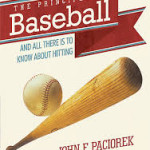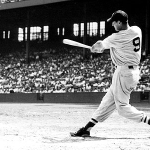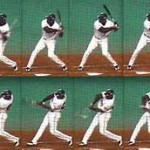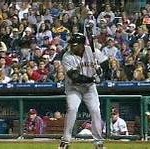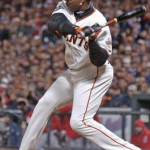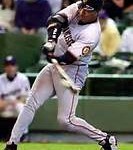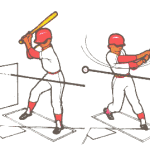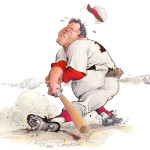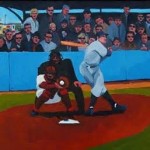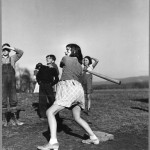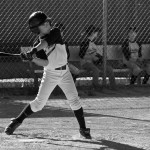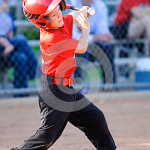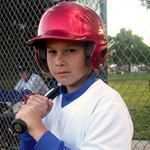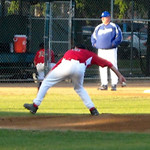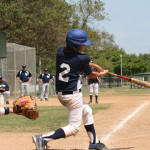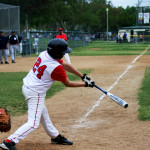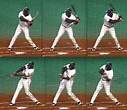Baseball in its Purist Form:
Individual, Collective, Universal Appeal
Ken Burn’s Baseball emphasizes the indigenous character and homespun heritage of our country’s National Pastime. By implication it can be inferred that the innovative and endearing qualities of America can transform a world willing to incorporate the essence of those qualities into an enduring fabric for their own mental and physical environments.
The Game of Baseball is the ultimate in sports activity! To all participants, players or fans, its unique simplicity conveys a human drama, and then reveals and resolves the complexities that would elicit trauma from life’s uncertain circumstances. Nine players take to the field with intent to defend what is considered their “turf” against the encroachment of others. They spend as little time as possible in defense of this nebulous expanse of territory, for, after a successful defensive stratagem, an opposing team of nine players gets an equal opportunity to defend what then becomes its territorial possession. And the game goes on for an indefinite period of time, normally expressed in terms accepted as “nine innings”.
“Could mere human contrivance order such preciseness, from the tri-hedral dimensions of the field of play, to the definitive specifications and range of intricate function for the designated participants?” – Socrates
A unique feature of the rules of engagement is the civility with which all participants are expected to conduct themselves, with respect to the range of their designated positions and the thoughtful concern for the well being of their opponents. A flagrant disrespect for either could instigate an immediate expulsion from the theater of play.
It would be difficult to exalt any particular field position above another, in rank or prestige, for it is incumbent upon each to perform equitably as various game circumstances present themselves. However, the prominence extolled to the “Pitcher” is unavoidable because he initiates and sustains the rhythm of play by his action of throwing the “ball” (baseball). The quality of the pitcher’s performance is determined by how well he is able to prevent the opposing player(s) from initiating action that would allow his (their) team to successfully encroach within the borders of pre-designated areas of defensive territory. The extent to which each “foil” to the pitcher is successful in fulfilling his goal will invariably determine which team wins the game.
In Baseball the singular concepts of individual and collective (team) excellence are intertwined masterfully. And the team that embodies such synergistic essence and complies with the highest standard of personal and collective excellence produces a “Championship” quality.
The high-quality pitcher is he who is adept at either preventing the “batter” (opposing player) from hitting the ball, or whose pitches prevent the batter from hitting the ball well. But, if the ball is hit, the pitcher expects his teammates to perform optimally when applying their fielding skills. Preventing the batter from permeating the invisible “shield” of defense and presenting his own offensive position on the “base-paths” is the mutual goal of the pitcher and his defensive team.
The first line in the “offensive” continuum is for a batter to get on the “base-paths,” either by hitting the ball, being struck by a pitched ball, or receiving a “base-on-balls”(4 errant pitches to the batter). Once the batter attains position on one the three bases (first, second, or third base), he becomes a “base-runner”, and another of his teammates becomes the batter. The new batter’s objective is to help advance or score the runner(s) from the base(s) of which he has taken possession.
Now, here is where one of the many variable and ingenious characteristics of the “Game” comes prominently into play. So many options for strategic deployment present themselves, from the thoughtfully reckless to the intuitively cautious — to gamble on whim or to hope in a pattern of consistency. And only the one that works gives credibility to the “brain and brawn” that accentuates “team-play”.
The proficiency of each player on offense and on defense will determine his individual worth. And the excellence towards which he strives for himself and his team will endear him to his mates and adoring fans. As each player accomplishes his own mastery, the team itself should be beneficiary to the product of a collectively successful enterprise. And each player should also become beneficiary to the collective worth of the team.
Baseball’s enduring attributes, to all levels of civilized society, are those which foster relevance to equal opportunity for the individual, and a sense of genuine contribution to a collective effort. These afford respect that cannot be diminished by an insignificant standard to a presumably less significant status. Every player in a line-up bats, and every position is held equally accountable for mental and physical errors. The standard is the same for all players! What can be a more fair way of evaluating performance? Is there any other arena of “Sports” that epitomizes the “American Dream” more than that displayed on Baseball’s level-field-of-play?
Why is Baseball an American institution? And how can it harmonize the World to the rhythm of its synchronistic appeal? The genius of Baseball is in its ability to promote individual excellence while cultivating the collective aspiration to a noble goal. This dual purpose can only be applauded for enhancing the prospect of continuous, enthusiastic hope by all participants, both active and vicarious.
Within the context of its everyday regimen, Baseball is first a one-on-one confrontation (Batter vs. Pitcher) like Boxing (normally without pugilistic intent and public vilification). This defines a separate but prominent dimension of the overall game. But every individual player is innately humbled by an awareness that his own vain and tenacious effort for personal glory pales in comparison to the satisfaction of attaining the triumphal exhilaration of a “Team” victory. When the team wins, against an overwhelming performance of an opposing pitcher, the “prickly” sensation of a batter’s hitless night somehow doesn’t seem so abrasive. And conversely, the magnificent individual effort of one man (pitcher, in this instance) gives no solace to the individual or his team if the greater goal of victory was not forthcoming.
In Baseball, the adage, “one for all, and all for one” rings true in the hearts and minds of these “9 Musketeers”, with their collectively idealistic sense of purpose. In Football, Basketball, Soccer, and Hockey not everyone is under the spotlight and given his equal opportunity to reflect even a glimmer of those majestic heights of glory that all players in Baseball are afforded. In football, the “linemen” hardly ever touch the ball; in soccer, the goalie and fullbacks never score; in hockey the same is true for goalie, and defensemen barely score; and in basketball, the small man is virtually non-existent. What other sport besides Baseball involves so many individuals in a collective endeavor, all having an equal opportunity to be exalted to the full range of glory, playing positions where equality of skill can not be differentiated for maximum results, where size never has to be a preponderant factor, and (potentially) where remuneration for services should never alienate players or create team dissension?
Baseball’s glorious competition triumphantly celebrates the athletic prowess of at least 18 stellar performers. And the drama enigmatically exemplifies the nation’s struggle as a free-spirited and ebullient exponent of a workable “democratic” society. Baseball is truly America’s national pastime. It not only epitomizes the “new-wave” national standard for American “equality for all”, but characterizes the highest sentiment for democratic reform throughout the world. Except for what could be considered brief lapses in moral consciousness (early segregationist issues, and its latter insidious bout with steroid controversy), the level playing field of Baseball has remained virtually intact, and its pristine elements are continually being unfolded. (Even the latest “Steroid Controversy” that has stirred up a hornet’s nest will ultimately subside, and the game will resume, but with a renewed sense of moral legitimacy.)
Many people, men, women, boys, and girls love to swing a baseball bat at a baseball (softball). It seems a pretty fair accomplishment—mentally sizing up the speed of that spherical object floating in a relatively straight path toward a designated area for the “batter” to physically strike with a long narrow cylindrical piece of wood or aluminum. It’s really fun! The skill involved is not just physical; the mental aspect includes the quick discernment of time, space, and geometric calculations, (and much more intense at the Big-League level). That’s why baseball (softball) games at family picnics, and other recreational environments, are such crowd-pleasing activities. And if no one gets hurt, it’s even more enjoyable!
For those who get involved at a more intricate level, like Little League and above, the game speeds up. The batter doesn’t seem to have as much control, as when dad or mom was pitching the ball. But the game is still fun; you just have to take it a little more seriously, more figuring and adjusting to more variables. And when your bat makes “good contact” the exhilaration is more intense and meaningful.
But as Ted Williams exclaimed, and probably many before him realized, and assuredly, every athlete who has been privileged to experience the physical, mental, and emotional tension associated with swinging a baseball bat under official game conditions can verify, “Hitting a baseball effectively is the most difficult thing to do in all of sports”. And even after many a would-be “big-leaguer” realizes he/she doesn’t have the fortitude (or opportunity) to climb the ladder to the pinnacle of baseball success, there remains in his/her heart a respect and appreciation for those who do persist. For, those who eventually do make it to the higher and highest levels have the empathy and undying support of all who wish they could be there too.
There are myriad challenges a batter has to surmount while encountering the diminutive, ballistic (and frequently volatile), compressed, spherical projectile at the highest level of play. Most dispassionate and well-rounded athletes would agree that making solid and forceful contact with a bat to a pitched ball takes extraordinary, nearly uncanny, skill. An extreme exponent of supreme athleticism, like Michael Jordan, had to curtail a personal quest for “carry-over” Sports glory, because he found the demands for “Batting” proficiency too daunting even for his premier sports status. One would have to query over what uncommon virtues characterize the “legitimate” Master of the Art of hitting a baseball. (The dilemma afforded by steroid use has purportedly usurped the crown of legitimacy from even those most venerable practitioners of the “art”.)
Hockey or Soccer will never become America’s sport, because neither originated in America. Soccer’s disproportionate propensity toward foot-eye coordination, although addressing good carry-over value for other sports, will never replace the allurement of Americans for premier hand and finger dexterity. And the question that thoughtful practitioners of peace might ask of those nations where soccer is most popular, “what is it about a culture that a sporting event can invoke such partisan disdain that players, spectators, and officials find their lives to be in jeopardy under circumstances that elicit an unfavorable conclusion to a contest?” And the overly “brutish” antics in Hockey have forever tarnished the sophistication of elegance and beauty that inherently characterize the movement of skates on ice. Stick-handling, passing and “shooting the puck”, and fast skating would be enough to endear the minds and hearts of most American spectators to a competitive sport that didn’t include the requisite debauchery of reckless body-checking and unmitigated violent confrontation with sticks and fists (weapons of war).
As the world has fast become a theatrical stage for public sentiment to display both outrageous and benevolent characterizations of humanity, a universal demand for the highest possible standard of excellence should be embodied by those who would be model-heroes for aspiring youth. Bickering over the trivialities concerning absurd compensatory packaging and equating successful performance levels to artificially inflating one’s artistic potential are two areas where public scrutiny will exhibit least toleration, even toward heroes. Once Baseball has cleaned up its Act on Steroid Controversy, and engages itself with its ever-expanding dilemma involving inequitable player compensation, then the certainty of its utopian appeal will be more in evidence. Until then, Baseball is still America’s endearing National Pastime.
